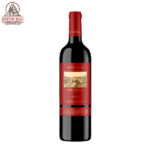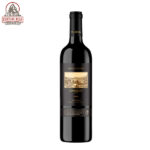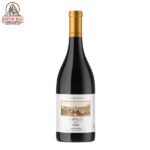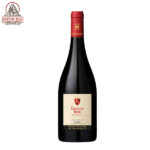Decanting wine is essentially the process of pouring (decanting) the contents from one vessel (typically a bottle) into another vessel (typically a decanter). Usually the wine is then served from the decanter, but sometimes in a restaurant it is decanted back into the original bottle for service.
Why decant wine?
Not every wine needs decanting. Many of us associate decanting with older vintage port wines or aged Bordeaux – wines that throw off a lot of sediment as they age. Decanting separates the wine from the sediment, which not only would not look nice in your glass, but would also make the wine taste more astringent. Slowly and carefully decanting the wine ensures that the sediment stays in the bottle and you get a nice clear wine in the decanter, and subsequently in your glass.
A second and more everyday reason to decant is to aerate the wine. Many young wines can be tight or closed on the nose or palate. As the wine is slowly poured from the bottle to the decanter it takes in oxygen, which helps open up the aromas and flavors. Highly tannic and full-bodied wines benefit most from this – wines such as Cabernet Sauvignon, Cabernet blends, Syrah, and Syrah blends.
Opponents of decanting for aeration purposes argue that swirling the wine in your glass has exactly the same effect and suggest that decanting can expose the wine to too much oxygen, leading to oxidation and dissipation of aromas and flavor – which is what you don’t want to happen. Personally I disagree with this view, unless you are decanting a very old red Burgundy wine, which is already very delicate and needs minimal oxygen exposure before drinking, or you decant the wine hours and hours before you plan on drinking it.
What Type of Decanter to use
There are many different shapes and styles of decanter available, so which one is right for you? There are two answers to this question; the official answer, and the unofficial answer.
 Officially, the shape and style of decante that you use, should support the style of wine that you’re drinking. Narrow style decanters for white wines, rose wine, and light bodies. Medium shaped and width decanters for medium bodied wines and large decanters for full bodied wines. The logic being that a larger shaped decanter will have a much bigger surface area to allow the wine to breath.
Officially, the shape and style of decante that you use, should support the style of wine that you’re drinking. Narrow style decanters for white wines, rose wine, and light bodies. Medium shaped and width decanters for medium bodied wines and large decanters for full bodied wines. The logic being that a larger shaped decanter will have a much bigger surface area to allow the wine to breath.
Unofficially, we would simply say that any decanter is better than no decanter and the easiest to clean is always the most practical style. Long, thin, bending necks are difficult to work with. Keep it simple.
What Wines Should I Be Decanting?
Cheap Wines
Decanting any cheap wines because it makes them taste better. Cheap wines can have really awkward rotten egg smell sometimes when you first open them due to sulphur dioxide. Our noses are very sensitive to this smell (some more than others) and it can ruin a wine tasting experience. Fortunately, often this smell can burn off very quickly after decanting wine and the resulting value wine can be very tasty!
Expensive Wines
Decanting expensive wines, especially massive cabernet sauvignons, Italian wines such as (Barolo, Chianti, aglianico, Montepulciano d’Abuzzo, super-Tuscans etc), Syrah, Malbec, Petite Sirah, etc.
White Wine and Pinot Noir
You can decant white wine and pinot noir, however, most do not really need it. You can however decant a very acidic pinot noir if you find it to be too tart, decanting will help smooth out the flavor a bit and make it more palatable.
How Long Should I Decant
Most of us drink red wines in the 2–10 year mark, so the following advice is tailored to regular drinking habits.
Red Wines
- Zinfandel: 30 minutes
- Pinot Noir: 30 minutes (e.g. red Bourgogne)
- Malbec: 1 hour
- Grenache/Garnacha Blend: 1 hour (e.g. Côtes du Rhône, Priorat, GSM)
- Cabernet Sauvignon or Merlot: 2 hours (e.g. Bordeaux)
- Petite Sirah: 2 hours
- Tempranillo: 2 hours (e.g. Rioja, Ribera del Deuro)
- Sangiovese: 2 hours (e.g. Brunello di Montalcino, Chianti)
- Vintage Port & Madeira: 2 hours
- Mourvèdre/Monastrell 2–3 hours (e.g. Bandol)
- Dão and Douro Reds: 2–3 hours
- Syrah/Shiraz: 2–3 hours
- Nebbiolo 3+ hours (e.g. Barolo, Barbaresco)
White Wines
Most white wines don’t need to be decanted, in fact, if the wine is highly aromatic decanting may hurt. Occasionally, however, white wines taste funky–like steamed mushrooms– and decanting will fix this! This flavor is common in full-bodied white wines from cooler climates like a white Bourgogne (e.g. Chardonnay). Decant for about 30 minutes.
Tips
How to tell if your wine is ready
This advice is more about how to adapt your expectations by tasting the wine before you start decanting to get a control. If the wine tastes great early on, drink it!
- Start by tasting it If there is very little fruit, overly tannic or hard to identify aromas, this means the wine is ‘closed’ and will need decanting.
- Try it again.Decant for the recommended time and taste it again. If the wine hasn’t changed much, keep waiting (30 min.–1 hour)
- Not Ready? If the wine is ready it will be noticeably more pleasant and aromatic. You should be able to smell fruit flavours. You’ll know that it’s ready because you’ll have a control. If it’s still not ready, try swirling it, double-decanting or aerating it.
Remember, any decanting is better than no decanting. Decant your wine for as long as you can but don’t over decant. Having a bottle ready before your guests arrive, or before you’re ready to drink it is always a good thing.





